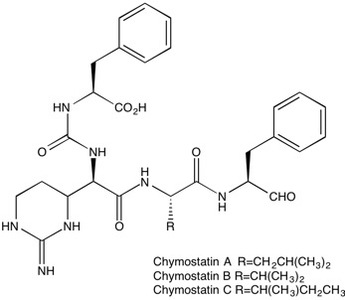Chymostatin | Inhibitor of Chymotrypsin-like serine proteases
NMR (Conforms)

Available Options
| Size : | Price | Quantity | |
|---|---|---|---|
| 5 mg | $98.00 | ||
| 25 mg | $400.00 |
Chymostatin (9076-44-2) is a potent, competitive, slow-binding inhibitor of a-, b-, g-, d-chymotrypsin, papain and cathepsins B/G (chymotryptase-like serine proteases)1, Ki=9.36 and 13.1 nM for chymotrypsin and chymase2. Cathepsin G Ki=0.15 mM.3 Consists of a mixture of type A (L-Leu), B (L-Val) and C (L-Ile) forms.1 Decreases plasma and tissue levels of angiotensin II without lowering mean blood pressure in a hypertensive rat model.4 Commonly used in lysis buffers to prevent degradation of proteins. Typical working concentration is 6-60 µg/ml.
References/Citations:
1) Umezawa et al. (1970), Chymostatin, a new chymotrypsin inhibitor produced by actinomycetes; J. Antibiot. (Tokyo) 23 425
2) Johnson et al. (1998), Inactivation of chymotrypsin and human skin chymase: kinetics of time-dependent inhibition in the presence of substrate; Biochim. Biophys. Acta 953 269
3) Stein and Strimpler (1987), Slow-binding of chymotrypsin and cathepsin G by the peptide aldehyde chymostatin; Biochemistry 26 2611
4) Roszkowska-Chojecka et al. (2015), Effects of chymostatin, a chymase inhibitor, on blood pressure, plasma and tissue angiotensin II, renal haemodynamics and renal excretion in two models of hypertension in the rat; Exp. Physiol. 100 1093
NMR (Conforms)
Safety Data Sheet:
Product Data Sheet:
Materials provided by Focus Biomolecules are for laboratory research use only and are not intended for human or veterinary applications. Please note that we do not sell to individuals and that all orders placed by non-research organizations will incur a $20 restocking/refund fee
Chymostatin (9076-44-2) is a potent, competitive, slow-binding inhibitor of a-, b-, g-, d-chymotrypsin, papain and cathepsins B/G (chymotryptase-like serine proteases)1, Ki=9.36 and 13.1 nM for chymotrypsin and chymase2. Cathepsin G Ki=0.15 mM.3 Consists of a mixture of type A (L-Leu), B (L-Val) and C (L-Ile) forms.1 Decreases plasma and tissue levels of angiotensin II without lowering mean blood pressure in a hypertensive rat model.4 Commonly used in lysis buffers to prevent degradation of proteins. Typical working concentration is 6-60 µg/ml.
References/Citations:
1) Umezawa et al. (1970), Chymostatin, a new chymotrypsin inhibitor produced by actinomycetes; J. Antibiot. (Tokyo) 23 425
2) Johnson et al. (1998), Inactivation of chymotrypsin and human skin chymase: kinetics of time-dependent inhibition in the presence of substrate; Biochim. Biophys. Acta 953 269
3) Stein and Strimpler (1987), Slow-binding of chymotrypsin and cathepsin G by the peptide aldehyde chymostatin; Biochemistry 26 2611
4) Roszkowska-Chojecka et al. (2015), Effects of chymostatin, a chymase inhibitor, on blood pressure, plasma and tissue angiotensin II, renal haemodynamics and renal excretion in two models of hypertension in the rat; Exp. Physiol. 100 1093
Calculate the molar concentration, mass or volume in a solution.
Concentration × Volume × Molecular Weight = Mass
Focus Biomolecules • Plymouth Meeting, PA USA • 1-855-FOCUS21
Focus Biomolecules
Plymouth Meeting, PA USA
1-855-FOCUS21
Website Created by Advanta Advertising LLC.

